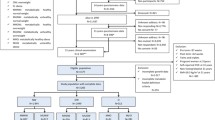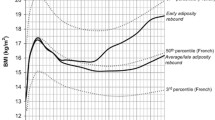Abstract
BACKGROUND: Birth order has been associated with variability in early life growth and subsequent obesity risk, but the consequent metabolic risks have not been assessed. OBJECTIVE: To quantify the metabolic risk in young adulthood of being first-born relative to those born second or subsequently. METHODS: Body composition, resting metabolic rate and metabolic risk were assessed in 383 women, aged 18–35 years, from a clinical setting in southern Italy. RESULTS: First-borns had increased body mass index, adiposity and metabolic risk (p<0.05) and increased resting metabolic rate adjusted for fat-free mass (p<0.05) in the Italian women. CONCLUSION: First-born status is associated with significantly elevated metabolic risk in a clinical population of overweight and obese young women attending a weight loss clinic. If these findings are confirmed in other studies, they may suggest that the prevalence of the metabolic syndrome worldwide may increase as a function of the trend to smaller family size.
Similar content being viewed by others
References
Stubbs RJ, Ritz P, Coward WA, et al. Covert manipulation of the ratio of dietary fat to carbohydrate and energy density: effect on food intake and energy balance in free-living men eating ad libitum. Am J Clin Nutr 1995; 62: 330–7.
O’Rahilly S, Farooqi IS. Human obesity as a heritable disorder of the central control of energy balance. Int J Obes 2008; 32: S55–61.
Stettler N, Tershakovec AM, Zemel BS, et al. Early risk factors for increased adiposity: a cohort study of African American subjects followed from birth to young adulthood. Am J Clin Nutr 2000; 72: 378–83.
Ong K, Preece MA, Emmett PM, et al; ALSPAC Study Team. Size at birth and early childhood growth in relation to maternal smoking, parity and infant breastfeeding: longitudinal birth cohort study and analysis. Pediatr Res 2002; 52: 863–7.
Dunger DB, Salgin B, Ong KK. Session 7: Early nutrition and later health Early developmental pathways of obesity and diabetes risk. Proc Nutr Soc 2007; 66: 451–7.
Leunissen R, Stijnen T, Hokken-Koelega ACS. Influence of birth size on body composition in early adulthood: the programming factors for growth and metabolism (PROGRAM)-study. Clin Endocrinol 2009; 70: 245–51.
Ekelund U, Ong KK, Linné Y, et al. Association of weight gain in infancy and early childhood with metabolic risk in young adults. J Clin Endocrinol Metab 2007; 92: 98–103.
Leunissen RW, Kerkhof GF, Stijnen T, et al. Timing and tempo of first-year rapid growth in relation to cardiovascular and metabolic risk profile in early adulthood. JAMA 2009; 301: 2234–42.
Boschi V, Siervo M, Nasti G, et al. Interdisciplinary treatment of a female outpatient population. Organizational model and preliminary results. Eat Weight Disord 2002; 7: 268–75.
Bioelectrical impedance analysis in body composition measurement. Am J Clin Nutr 1996; 64: 387S–532S.
Siervo M, Boschi V, Falconi C. Which REE prediction equation should we use in normal-weight, overweight and obese women? Clin Nutr 2003; 22: 193–204.
Vanitallie T, Yang MU, Heymsfield SB, et al. Heightnormalised indices of the body’s fat free mass and fat mass: potentially useful indicators of nutritional status. Am J Clin Nutr 1990; 52: 953–9.
Brage S, Wedderkopp N, Ekelund U, et al. Features of the metabolic syndrome are associated with objectively measured physical activity and fitness in Danish children. Diabetes Care 2004; 27: 2141–8.
Criscuolo F, Monaghan P, Nasir L, et al. Early nutrition and phenotypic development: catch-up growth leads to elevated metabolic rate in adulthood. Proc Biol Sci 2008; 275: 1565–70.
Barker DJP. The origins of the developmental origins theory. J Intern Med 2007; 261: 412–7.
Hales CN, Barker DJP. Type 2 (non-insulin-dependent) diabetes mellitus: the thrifty phenotype hypothesis. Diabetologia 1992; 35: 595–601.
Author information
Authors and Affiliations
Corresponding author
Rights and permissions
About this article
Cite this article
Siervo, M., Stephan, B.C.M., Colantuoni, A. et al. First-borns have a higher metabolic rate and carry a higher metabolic risk in young women attending a weight loss clinic. Eat Weight Disord 16, e171–e176 (2011). https://doi.org/10.1007/BF03325128
Received:
Accepted:
Published:
Issue Date:
DOI: https://doi.org/10.1007/BF03325128




